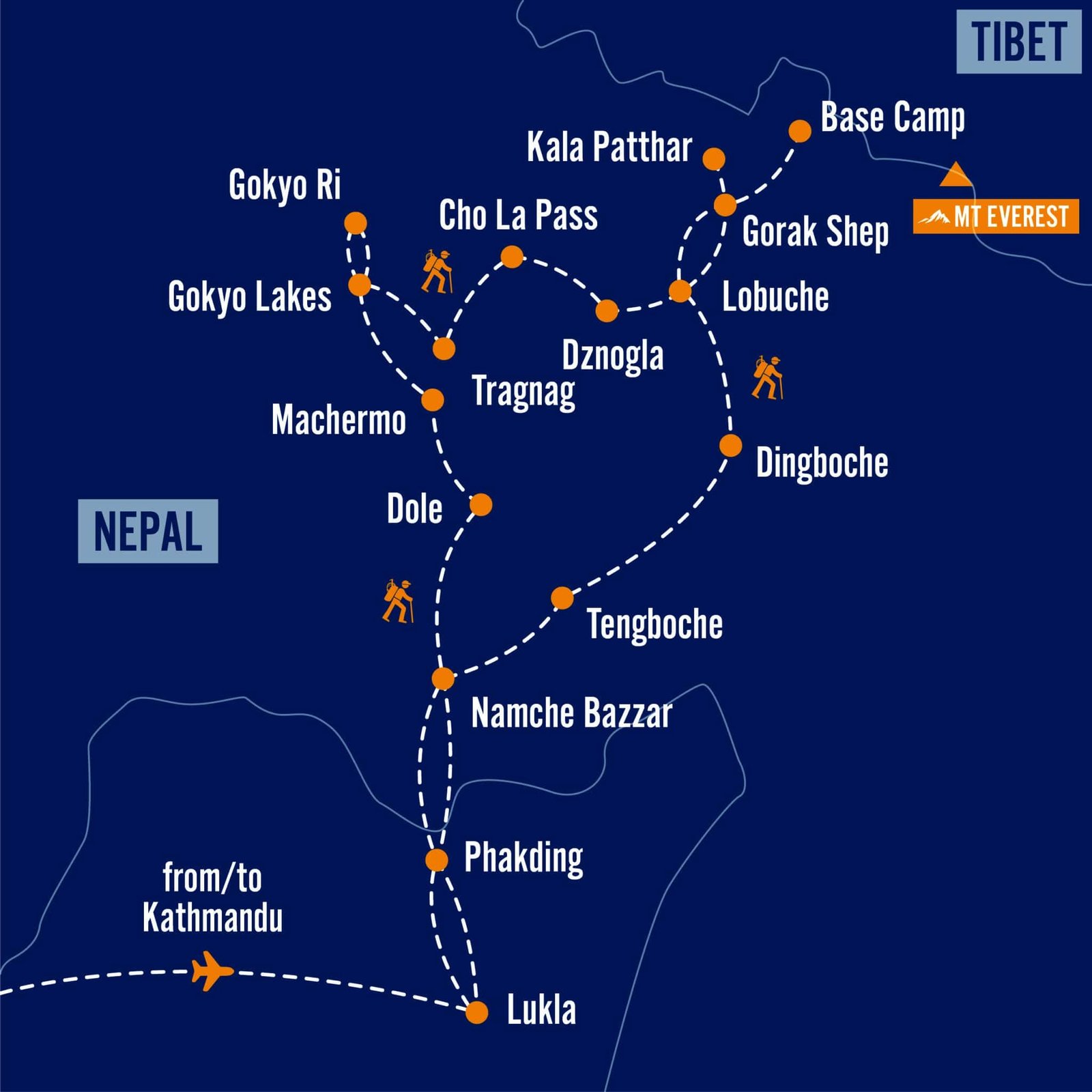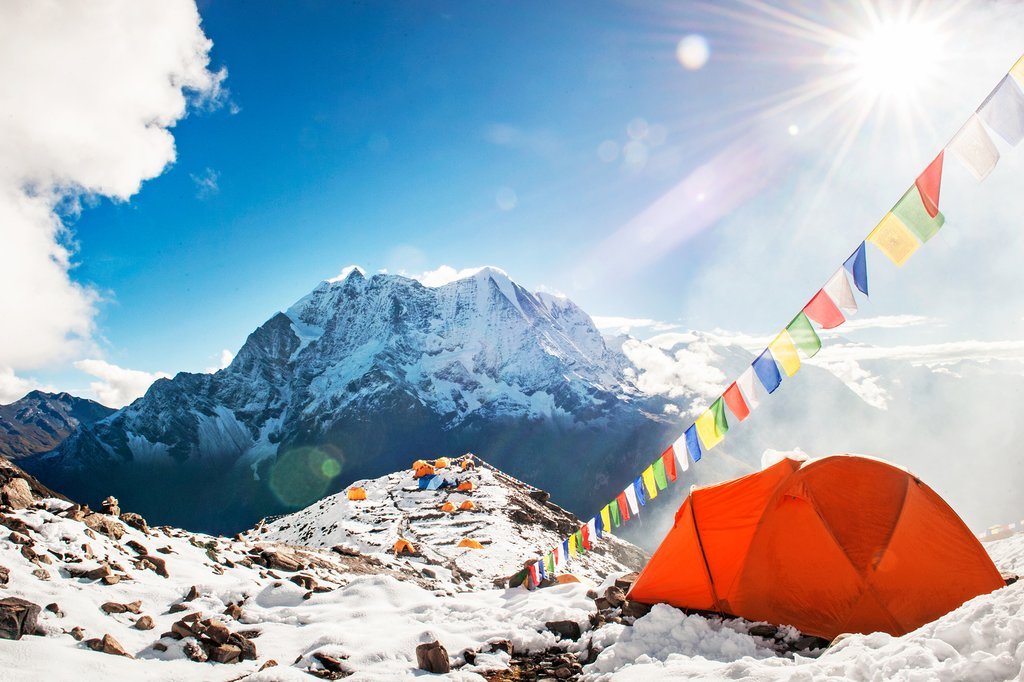Nestled in the heart of the Himalayas, Everest Base Camp (EBC) presents a challenging environment for both trekkers and mountaineers. This renowned destination sits at an elevation of 5,364 meters (17,598 feet) above sea level, placing it in the high-altitude zone where the human body encounters physiological changes to adapt to the reduced oxygen levels.

The diminished oxygen, characterized by lower barometric pressure at high altitudes, triggers a series of compensatory mechanisms in the body. The body responds by increasing its respiratory rate and heart rate to deliver more oxygen to vital organs and tissues. These physiological adjustments are aimed at maintaining adequate oxygen levels in the body, particularly for the brain and other vital functions.

Acclimatization plays a crucial role in the success and safety of adventurers venturing to EBC. Allowing the body to gradually adapt to the high altitude is essential to prevent altitude sickness, a range of symptoms commonly experienced at elevations above 2,500 meters (8,200 feet). Acclimatization typically involves ascending gradually, spending rest days at strategic altitudes, and maintaining a regular hydration and balanced nutrition regimen.

At EBC, the atmospheric pressure is approximately half of that at sea level, resulting in a significant reduction in oxygen concentration. This oxygen deprivation can lead to various symptoms, collectively known as altitude sickness. Common symptoms include shortness of breath, headache, fatigue, nausea, and loss of appetite. In severe cases, altitude sickness can progress to high altitude pulmonary edema (HAPE) or high altitude cerebral edema (HACE), life-threatening conditions requiring immediate medical attention.
To minimize the risk of altitude sickness, gradual ascent and proper acclimatization are paramount. Trekkers and mountaineers should avoid rapid ascents and allow ample time for the body to adjust to the decreasing oxygen levels. Additionally, maintaining adequate hydration, consuming a nutritious diet, and avoiding alcohol and smoking are essential precautions. Recognizing the symptoms of altitude sickness and seeking medical assistance promptly are crucial for the safety of individuals at EBC.
Pushing the boundaries of human endurance, EBC presents a unique and awe-inspiring destination for those seeking adventure and personal challenge. Understanding the physiological effects of high altitude and adhering to proper acclimatization protocols are essential for a safe and successful journey to Everest Base Camp.## High-altitude Health: Understanding Everest Base Camp’s Elevation
Executive Summary
This article comprehensively explores the health implications of high-altitude environments, particularly focusing on the elevation of Mount Everest’s base camp. Through an examination of various physiological responses and potential health risks associated with high altitudes, travelers and mountaineers can prepare for and mitigate the effects of altitude on their health.
Introduction
Mount Everest, the world’s highest peak, attracts mountaineers and trekkers from around the globe. However, the extreme altitude of Everest’s base camp, located at 5,364 meters (17,598 feet), poses significant health challenges. Understanding these challenges can help individuals prepare and minimize risks while enjoying the wonders of the Himalayas.
Altitude Sickness:
Altitude sickness, also known as acute mountain sickness (AMS), can affect individuals at high altitudes, including those at Everest’s base camp. Symptoms range from mild to life-threatening and include headache, nausea, fatigue, and shortness of breath.
- Acclimatization: Gradual ascent and appropriate time for acclimatization can reduce the risk of AMS.
- Hydration: Staying hydrated is vital at high altitudes, as the body loses fluids more rapidly.
- Medications: Acetazolamide and ibuprofen can help alleviate AMS symptoms.
- Recognition of Severe Symptoms: Recognizing and promptly addressing severe symptoms, such as confusion or loss of consciousness, is crucial.
Hypothermia:
Hypothermia occurs when the body loses heat faster than it can produce it, leading to a dangerously low body temperature. At high altitudes, hypothermia can set in quickly due to cold temperatures and wind chill.
- Layering: Wearing multiple layers of clothing, including a windproof and waterproof outer layer, is essential.
- Proper Foot Wear: Wearing insulated and waterproof boots can prevent frostbite and hypothermia of the feet.
- Energy Replenishment: Consuming calorie-rich foods and fluids helps maintain body heat.
- Immediate Treatment: Shivering, slurred speech, and confusion are signs of hypothermia that require immediate attention.
High Altitude Pulmonary Edema (HAPE):
High Altitude Pulmonary Edema (HAPE) is a severe condition characterized by fluid buildup in the lungs. It can lead to shortness of breath, coughing, and, in severe cases, death.
- Medical History: Individuals with pre-existing heart or respiratory conditions are more prone to HAPE.
- Rapid Ascent: Rapid ascent to high altitudes increases the risk of HAPE.
- Medications: Dexamethasone and nifedipine can be used to treat HAPE.
- Descend: The most effective treatment for HAPE is to descend to a lower altitude immediately.
High Altitude Cerebral Edema (HACE):
High Altitude Cerebral Edema (HACE) is a life-threatening condition caused by fluid buildup in the brain. Symptoms include headache, nausea, vomiting, and impaired consciousness.
- Prevention: Slow ascent and adequate acclimatization can help prevent HACE.
- Recognition of Symptoms: Recognizing the symptoms of HACE and taking immediate action is crucial.
- Treatment: Treatment involves oxygen therapy, dexamethasone, and immediate descent.
Other Considerations:
- Nutrition: A balanced diet is essential for maintaining energy levels and supporting the body’s adaptation to high altitudes.
- Sleep: Getting adequate sleep aids in acclimatization and recovery.
- Hygiene: Maintaining proper hygiene, especially handwashing, helps prevent infections.
Conclusion
Understanding the health risks associated with high altitudes, particularly Everest’s base camp elevation, is paramount for travelers and mountaineers embarking on such journeys. Proper preparation, acclimatization, and awareness of potential symptoms can help minimize these risks and ensure a safe and enjoyable experience in the Himalayas.
Keyword Phrase Tags:
- Everest Base Camp Elevation
- High-altitude Health Risks
- Altitude Sickness Prevention
- High Altitude Pulmonary Edema
- High Altitude Cerebral Edema